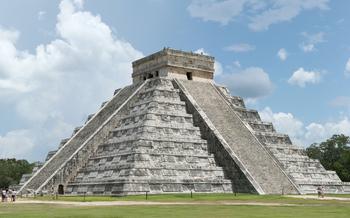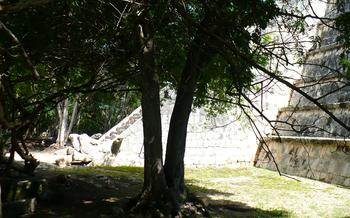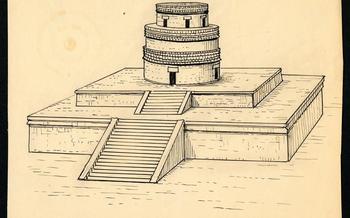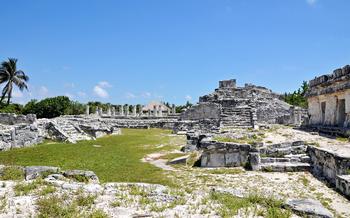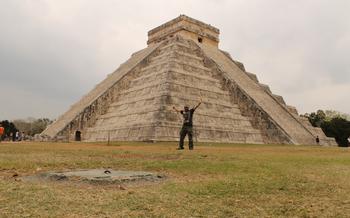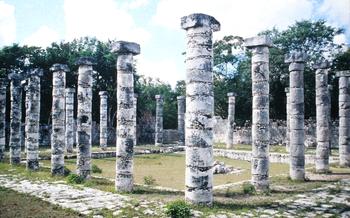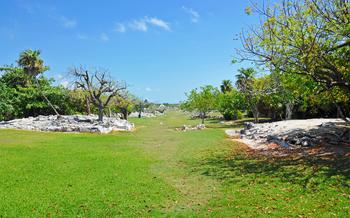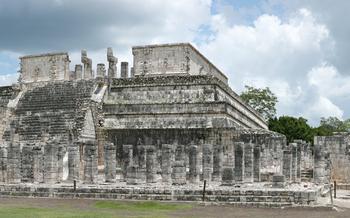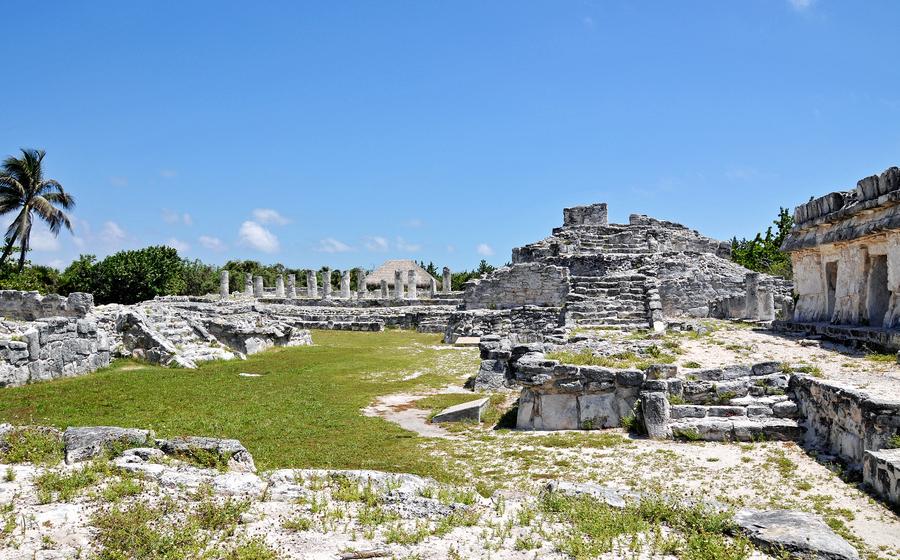
Yaxunah
- The Wonder of Chichen Itza:
- Unlocking the Secrets of the Yaxunah Cenote:
- A Journey Through Time: The Chichen Itza Main Square
- The Grandeur of the Main Square
- Exploring the Structures Within the Square
- The Symbolism and Astronomical Significance of the Structures
- Tips for Capturing Stunning Photographs
- El Castillo - Unveiling the Mayan Pyramid
- Exploring the Temple of the Warriors
- The Great Ball Court - Witnessing Mayan Sports
- The Cenote Sagrado - A Sacred Ritual Ground:
- The Observatory - Unveiling Mayan Astronomy
- The Temple of the Jaguars - Unveiling a Royal Tomb
- The Temple of the Skulls - A Place of Sacrifice
- Las Monjas - Exploring a Majestic Convent
- The Tzompantli - Unveiling the Skull Rack
- The Museum of Chichen Itza - A Treasure Trove of Mayan Artifacts
- Shopping in Chichen Itza - Discovering Local Treasures
- Insider Tip: Unforgettable Sunrise Experience
The Wonder of Chichen Itza:
Dive into the heart of the ancient Mayan civilization as we explore the awe-inspiring city of Chichen Itza. Located in the Yucatan Peninsula of Mexico, this UNESCO World Heritage Site boasts a captivating blend of history, culture, and natural beauty. Step through the gates of time and discover the remnants of a once-thriving metropolis, where towering pyramids, sacred cenotes, and intricate carvings narrate tales of a civilization that reached remarkable heights of astronomical knowledge and architectural prowess.
As you walk amidst the ruins, let your imagination soar and picture the bustling streets, the ceremonies honoring Mayan deities, and the echoes of a vibrant community that once called this place home. Prepare to be captivated by the grandeur of Chichen Itza, a testament to human ingenuity and a symbol of the enduring legacy of the Maya.
Unlocking the Secrets of the Yaxunah Cenote:
Hidden deep within the lush jungles of Chichen Itza lies a natural wonder that beckons travelers with its allure - the Yaxunah Cenote. A sacred site for the ancient Mayans, this cenote holds a special place in the history and culture of the region.
What truly sets the Yaxunah Cenote apart is its unique underwater cave system. Visitors can explore the depths of this flooded labyrinth, discovering hidden chambers and marveling at the spectacular stalactites and stalagmites that adorn its walls. The crystal-clear waters offer unparalleled visibility, making it an ideal spot for snorkeling and diving enthusiasts.
Legends and myths surround the Yaxunah Cenote, captivating the imaginations of visitors. One tale speaks of a hidden city beneath the cenote's surface, accessible only to those who possess a pure heart. Another legend tells of a Mayan princess who sought refuge in the cenote to escape an arranged marriage, forever binding her spirit to its depths.
For those seeking a truly immersive experience, a visit to the Yaxunah Cenote is a must. Whether you choose to swim, snorkel, or dive, the cenote's pristine waters and enchanting atmosphere will leave you spellbound.
Practical Information for Visitors:
- Accessibility: The Yaxunah Cenote is easily accessible by car or guided tour from Chichen Itza.
- Entrance Fees: There is a small entrance fee to visit the cenote, which helps support its conservation efforts.
- Facilities: Basic facilities such as changing rooms and restrooms are available near the cenote.
- Safety: Always swim or dive with a buddy and adhere to safety guidelines posted at the cenote.
- Eco-Friendliness: Please respect the natural environment and avoid using sunscreen or insect repellent that may harm the delicate ecosystem of the cenote.
A Journey Through Time: The Chichen Itza Main Square
The main square of Chichen Itza, known as the Great Plaza, is a testament to the grandeur and sophistication of the Mayan civilization. Spanning over 200 meters in length and width, this vast open space is flanked by iconic structures that showcase the Mayans' architectural prowess and their deep connection to the cosmos.
The Grandeur of the Main Square
The main square commands attention with its sheer size and symmetry. As you step into this ancient plaza, you are met with a breathtaking vista of monumental buildings, each with its own unique story to tell. The square is bordered by the towering El Castillo pyramid to the north, the Temple of the Warriors to the west, the Great Ball Court to the south, and the Temple of the Skulls to the east.
Exploring the Structures Within the Square
At the heart of the main square lies the sacred cenote, a natural well that was considered a portal to the Mayan underworld. The cenote is surrounded by a ceremonial platform and a series of smaller temples, creating a sacred precinct that was used for religious rituals and ceremonies.
The Symbolism and Astronomical Significance of the Structures
The structures within the main square are not merely architectural marvels; they also hold deep symbolic and astronomical significance. The placement and alignment of these buildings were carefully planned to reflect the Mayans' understanding of the cosmos and their reverence for celestial events.
Tips for Capturing Stunning Photographs
To capture the grandeur of the main square, be sure to arrive early in the morning or late in the afternoon to avoid the crowds and harsh midday sun. Use a wide-angle lens to capture the scale and symmetry of the square, and experiment with different angles to find unique perspectives. Don't forget to look up to capture the intricate carvings and details that adorn the buildings.
El Castillo - Unveiling the Mayan Pyramid
Majestic and awe-inspiring, El Castillo stands as the heart of Chichen Itza, a testament to Mayan ingenuity and architectural prowess. Towering over the ancient city, this iconic pyramid beckons visitors to unravel its captivating history and profound significance.
El Castillo, also known as the Pyramid of Kukulcan, was constructed between the 9th and 12th centuries as a temple dedicated to the Mayan deity Kukulcan, the feathered serpent god. Its construction showcases the Mayans' remarkable understanding of astronomy, mathematics, and engineering.
The pyramid's four sides align precisely with the cardinal directions, and its 365 steps represent the days of the solar year. During the spring and autumn equinoxes, a spectacular light and shadow effect occurs, creating the illusion of a serpent descending the pyramid's northern staircase - a mesmerizing sight that draws visitors from around the world.
Climbing the pyramid's steep steps is an exhilarating experience that offers breathtaking panoramic views of the surrounding jungle and ancient ruins. At the summit, visitors are rewarded with an up-close encounter with the pyramid's intricate carvings and sculptures, which depict Mayan deities, historical events, and astronomical symbols.
While climbing El Castillo is an unforgettable experience, it's important to note that the ascent is challenging and requires a good level of fitness. Sturdy shoes and comfortable clothing are recommended, and visitors should be prepared for the heat and humidity.
Exploring the Temple of the Warriors
The Temple of the Warriors, a testament to the architectural prowess of the Mayans, stands tall within the awe-inspiring city of Chichen Itza. This colossal structure, dedicated to revered warriors and deities, embodies the essence of Mayan culture and spirituality.
As you approach the temple, its grandeur captivates, drawing you into a journey through time and history. Its imposing facade, adorned with intricate carvings and sculptures, offers a glimpse into the artistry and craftsmanship of the Mayans. The temple's design reflects the sophisticated engineering and mathematical knowledge possessed by this ancient civilization.
Venturing inside, you are met with a series of chambers, each showcasing unique features and symbolic elements. The walls are adorned with vibrant murals depicting scenes of battles, religious ceremonies, and everyday life, offering a glimpse into the rich tapestry of Mayan society. The intricate carvings and sculptures that embellish the temple depict mythical creatures, deities, and scenes from Mayan mythology, providing a deeper understanding of their beliefs and spiritual practices.
The Temple of the Warriors holds immense historical and cultural significance. It served as a temple for religious ceremonies and rituals, a gathering place for the community, and a symbol of the city's military prowess. Its construction showcases the architectural prowess of the Mayans, who possessed advanced knowledge of engineering, mathematics, and astronomy.
To fully appreciate the grandeur of the Temple of the Warriors, it is essential to take your time exploring its various chambers and marveling at the intricate details. Capture the essence of this architectural masterpiece through stunning photographs, ensuring you capture the interplay of light and shadow that enhances the temple's beauty.
Whether you are a history enthusiast, an architecture aficionado, or simply a traveler seeking to immerse yourself in the wonders of ancient civilizations, the Temple of the Warriors is a must-visit destination. It offers a profound connection to the past and a deeper understanding of the rich cultural heritage of the Mayans.
The Great Ball Court - Witnessing Mayan Sports
Amidst the awe-inspiring ruins of Chichen Itza lies the Great Ball Court, a testament to the Mayans' athletic prowess and cultural significance. Measuring an impressive 545 feet in length and 225 feet in width, this colossal arena was once the stage for a ritualistic sport that captivated the ancient Maya civilization.
The ball game, known as Pok-ta-Pok, was not merely a sport but a sacred ritual deeply intertwined with Mayan mythology and religious beliefs. Played by two teams of seven players, the objective was to propel a solid rubber ball through a stone hoop suspended high on the walls of the court. The rules were intricate, and the game often carried political and religious overtones.
Beyond its sporting significance, the Great Ball Court holds a unique acoustic phenomenon. If you stand at the center of the court and clap your hands, you'll hear an eerie echo that resonates throughout the entire structure. This effect is attributed to the court's specific dimensions and the positioning of its walls, creating a remarkable acoustic experience that adds to the mystique of the site.
To capture the essence of the Great Ball Court, position yourself at one end of the court and frame your shot to include the entire expanse of the arena. If you're fortunate enough to visit during a clear night, the stars above the court create a breathtaking backdrop for your photographs.
The Cenote Sagrado - A Sacred Ritual Ground:
Immerse yourself in the mystical allure of the Cenote Sagrado, a natural wonder revered by the ancient Mayans as a sacred site of spiritual significance. Plunge into the depths of this subterranean marvel, surrounded by towering limestone walls and bathed in ethereal light filtering through the jungle canopy. Allow the crystal-clear waters to envelop you, creating a surreal experience as you float amidst the tranquil depths.
The Cenote Sagrado, meaning "Sacred Cenote," was considered a gateway to the underworld, a place where the Mayans believed they could communicate with their deities and ancestors. They performed elaborate rituals and ceremonies here, seeking guidance and protection from the divine forces that governed their lives. It was also a place of pilgrimage, where people from across the Mayan realm journeyed to pay homage and make offerings to the gods.
Descend into the cenote through a narrow opening in the ground, revealing a breathtaking spectacle of natural beauty. The cenote's waters are said to possess healing properties, and many visitors come to bathe in its sacred depths, seeking purification and renewal. As you immerse yourself in the cenote's tranquil embrace, feel a sense of serenity wash over you, connecting you to the spiritual essence of this ancient site.
When visiting the Cenote Sagrado, it is important to approach it with respect and reverence. Remember that this is a sacred place that holds deep spiritual significance for the Mayan people. Observe proper etiquette by dressing modestly and refraining from loud noises or disruptive behavior. Take your time to soak in the atmosphere, appreciate the beauty of the surroundings, and connect with the spiritual energy that permeates this mystical realm.
The Observatory - Unveiling Mayan Astronomy
The Mayans were renowned for their advanced knowledge of astronomy, and Chichen Itza was a significant center for astronomical observations. The Observatory, known as El Caracol, stands as a testament to their ingenuity and understanding of the cosmos. Built in the 10th century, this circular structure features a spiral staircase leading to a small chamber with windows aligned with key celestial events.
The Mayans used the Observatory to track the movements of the sun, moon, and stars, which held great importance in their religious beliefs and agricultural practices. By observing the positions of these celestial bodies, they were able to predict solstices, equinoxes, and eclipses with remarkable accuracy.
The Observatory also served as a calendar, with the windows aligned to mark important dates and events. The Mayans believed that the movements of the heavens influenced life on Earth, and the Observatory allowed them to align their rituals and ceremonies with the cosmos.
Today, visitors can climb the spiral staircase and experience firsthand the ingenuity of the Mayan astronomers. The chamber at the top offers stunning views of the surrounding landscape, and visitors can imagine the Mayan priests and astronomers gazing out at the night sky, deciphering the secrets of the universe.
Tips for visiting the Observatory:
- Visit the Observatory at night to see the stars aligned with the windows.
- Bring a flashlight to help you navigate the dark chamber.
- Take your time to explore the Observatory and learn about its significance.
- Capture the beauty of the night sky with your camera or smartphone.
The Temple of the Jaguars - Unveiling a Royal Tomb
Deep within the heart of the ancient city of Chichen Itza lies a magnificent structure that holds a captivating tale of power, royalty, and the afterlife - the Temple of the Jaguars. This awe-inspiring temple, adorned with intricate carvings and sculptures, served as a sacred burial ground for the Mayan elite, offering a glimpse into the rich cultural and religious traditions of this ancient civilization.
The temple's facade is a testament to the Mayans' architectural prowess, featuring a series of imposing columns adorned with intricate carvings depicting snarling jaguars, a symbol of strength and power in Mayan mythology. The interior of the temple is equally captivating, with a series of chambers and passageways leading to a hidden chamber - the royal tomb.
Discovered by archaeologists in the 1930s, the royal tomb contained the remains of a high-ranking Mayan ruler, along with an array of precious artifacts, including jade masks, gold jewelry, and ceramic vessels. These artifacts provide valuable insights into the burial practices and beliefs of the ancient Mayans, shedding light on their reverence for their rulers and their belief in the afterlife.
Visiting the Temple of the Jaguars is a truly immersive experience, allowing visitors to step back in time and imagine the grandeur and opulence that once filled these sacred halls. The temple stands as a testament to the ingenuity and artistry of the Mayan civilization, offering a glimpse into the lives and beliefs of this enigmatic people.
The Temple of the Skulls - A Place of Sacrifice
Amidst the grandeur of Chichen Itza, the Temple of the Skulls stands as a chilling reminder of the Maya's complex and sometimes macabre rituals. Dedicated to the god of death, this temple is steeped in a history of human sacrifice and holds a dark fascination for visitors.
Approaching the temple, you'll be struck by its imposing presence. The facade is adorned with intricate carvings and sculptures depicting human skulls, a testament to the temple's grim purpose. Inside, the atmosphere is heavy with a sense of foreboding as you navigate through dimly lit chambers and narrow passageways.
The most striking feature of the temple is the tzompantli, or skull rack, located at the rear of the main chamber. This gruesome display consists of hundreds of human skulls, arranged in rows and columns, their empty eye sockets staring out into the void. The skulls are believed to have belonged to sacrificial victims, their remains serving as a warning to those who dared to defy the Maya gods.
While the Temple of the Skulls may not be for the faint of heart, it offers a unique glimpse into the Maya's complex belief system and the rituals that were once practiced here. It's a reminder that even the most advanced civilizations are capable of great brutality, and that the line between life and death was often blurred in the ancient Maya world.
Las Monjas - Exploring a Majestic Convent
Las Monjas, meaning "The Nuns," is a captivating complex within the ancient city of Chichen Itza. While its name suggests a religious association, it was actually a palace or an administrative building constructed by the Mayans. Its architectural style is distinct from other structures in Chichen Itza, showcasing an elegant combination of Puuc and Chenes elements.
The complex consists of several interconnected buildings arranged around courtyards and plazas. Visitors can wander through the well-preserved corridors and chambers, admiring the intricate carvings and sculptures that adorn the walls. The artistry depicts various scenes from Mayan life, including religious rituals, historical events, and everyday activities.
Las Monjas holds historical significance as it was once a vibrant center of Mayan society. It served as a residential palace for the ruling elite, housing important officials, priests, and their families. The complex also had administrative functions, with rooms dedicated to conducting meetings, planning ceremonies, and managing the affairs of the city.
Capturing the essence of Las Monjas through photography requires patience and an eye for detail. The play of light and shadow creates dramatic effects, especially during the golden hours of sunrise and sunset. Experiment with different angles to highlight the architectural features and the intricate carvings that narrate the stories of the ancient Maya.
The Tzompantli - Unveiling the Skull Rack
Amidst the grandeur of Chichen Itza lies a chilling reminder of the Mayans' complex belief system and rituals: the Tzompantli, or skull rack. This gruesome structure, located near the Great Ball Court, served as a public display of severed heads, showcasing the power and might of the Mayan empire.
The Tzompantli, a low platform with holes carved into the top, was used to impale the skulls of defeated enemies, sacrificial victims, and prisoners of war. These skulls were arranged in rows, creating a macabre spectacle that both honored the gods and instilled fear in the hearts of those who beheld it.
Archaeological excavations at the Tzompantli have revealed a wealth of information about Mayan rituals and beliefs. The skulls found here often bear signs of mutilation, suggesting that they were carefully prepared before being displayed. Some skulls show evidence of dental modifications, such as filing or inlays, indicating that the individuals may have held high status within Mayan society.
Visiting the Tzompantli is a sobering experience that offers a glimpse into the darker aspects of Mayan culture. While it may be unsettling, it is an important reminder of the complexity and diversity of human history.
The Museum of Chichen Itza - A Treasure Trove of Mayan Artifacts
The Museum of Chichen Itza is a captivating treasury of Mayan history and culture. Here, visitors can embark on a journey through time, immersing themselves in the legacy of this ancient civilization. The museum showcases an extensive collection of artifacts, each piece meticulously preserved and displayed, offering glimpses into the lives and beliefs of the Mayans. From intricately carved sculptures to pottery adorned with vivid colors, every exhibit narrates a story of this extraordinary civilization.
Step into the museum, and you'll find yourself surrounded by a wealth of knowledge. Curated with care, the exhibits take you on a chronological exploration of Mayan history, showcasing the evolution of their culture over centuries. Learn about the origins of the Mayans, their rise to prominence, and the factors that shaped their civilization. The museum's collection includes ceramics, jade ornaments, obsidian tools, and an array of other artifacts that provide tangible evidence of Mayan ingenuity and artistry.
One of the highlights of the museum is the collection of stone sculptures, which depict various Mayan deities, rulers, and mythological figures. These sculptures offer a glimpse into the religious beliefs and practices of the Mayans. The intricate details and expressive features of these carvings showcase the exceptional craftsmanship of Mayan artisans.
The Museum of Chichen Itza is not merely a repository of artifacts; it's a gateway to understanding the Mayan civilization. Through its well-curated exhibits, the museum provides a deeper appreciation for the cultural heritage and achievements of the Mayans. It's a must-visit for anyone seeking to unravel the mysteries of this ancient civilization.
Shopping in Chichen Itza - Discovering Local Treasures
Immerse yourself in the vibrant atmosphere of Chichen Itza's bustling markets, where the air is filled with the sounds of haggling and the aroma of local delicacies. Discover an array of handcrafted treasures, from intricate pottery and woven textiles to colorful masks and traditional clothing. These markets are a haven for souvenir hunters and art enthusiasts alike, offering a glimpse into the rich cultural heritage of the region. Engage with the friendly local vendors, who are always willing to share stories about their craft and the significance of their creations. Don't be afraid to bargain and negotiate prices, as it's all part of the experience. Remember, by supporting local artisans, you're not only taking home a unique piece of Chichen Itza, but also contributing to the preservation of traditional Mayan culture.
Insider Tip: Unforgettable Sunrise Experience
As the sky begins to blush with the hues of a new day, Chichen Itza awakens from its slumber, casting an ethereal glow upon its ancient structures. The first rays of sunlight bathe the majestic El Castillo pyramid in a golden embrace, creating a breathtaking spectacle that will forever etch itself into your memory.
To capture this magical moment, position yourself strategically opposite the pyramid, ensuring that the rising sun aligns perfectly with its towering silhouette. As the sun emerges from the horizon, the pyramid's sharp angles and intricate carvings will be illuminated in a way that is both awe-inspiring and serene.
For the best sunrise experience, plan your visit carefully. Aim to arrive at Chichen Itza at least 30 minutes before sunrise to secure a good spot and soak in the tranquil atmosphere as the world comes to life. Remember to bring your camera and a tripod to capture the perfect shot of this unforgettable spectacle.
